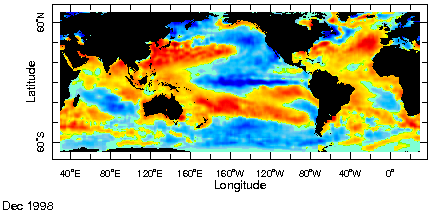
| ||||
IRI Climate Information Digest - December 1998
HighlightsLa Niña Matures The area extent of relatively cold equatorial waters has expanded over the past several months. By December 1998 the magnitude and extent of the La Niña were becoming comparable to the 1988 cold episode. The strongest negative sea surface temperature departures extend from the dateline eastwards to the central eastern Pacific. An area of above average sea surface temperature that lies to the south of the equator in the eastern Pacific is not of sufficient magnitude nor in an optimal position to significantly influence the atmosphere. Recent numerical and statistical forecasts suggest this cold episode will slowly decrease in magnitude over the next several months.Precipitation Patterns Many of the typical La Niña rainfall patterns are now evident. These include enhanced rainfall in the far west Pacific, northern Australia, and southern Africa and drier conditions in central equatorial Pacific, eastern Equatorial Africa and southeastern South America. La Niña related spatial contrast in dry-wet rainfall patterns are particularly strong in the central (dry) to western (wet) Pacific and in Africa. Extremely dry conditions characterize the area from northern Mozambique northward through Ethiopia in strong contrast to heavy rainfall to the south through much of South Africa. Rainfall patterns not directly related to the La Niña include a continuation of dry conditions in the Iberian Peninsula and Morocco, an excess rainfall in an area surrounding the Adriatic, and dry conditions in the far eastern Mediterranean and Near East including parts of Iran, Iraq, and Saudi Arabia. Slight variations of this dry-wet-dry pattern have characterized these areas for the past several months. Dry conditions continued to effect the east coast of North America. Global Temperatures
The December global mean temperatures were above the long term average,
completing a year of above average temperatures and contributing to the
warmest year in the instrumental record (see the Nov 1998 Climate Information
Digest). Average December temperature departures for continental
areas were positive except for South America which experienced average
to colder than average in most areas.
|

